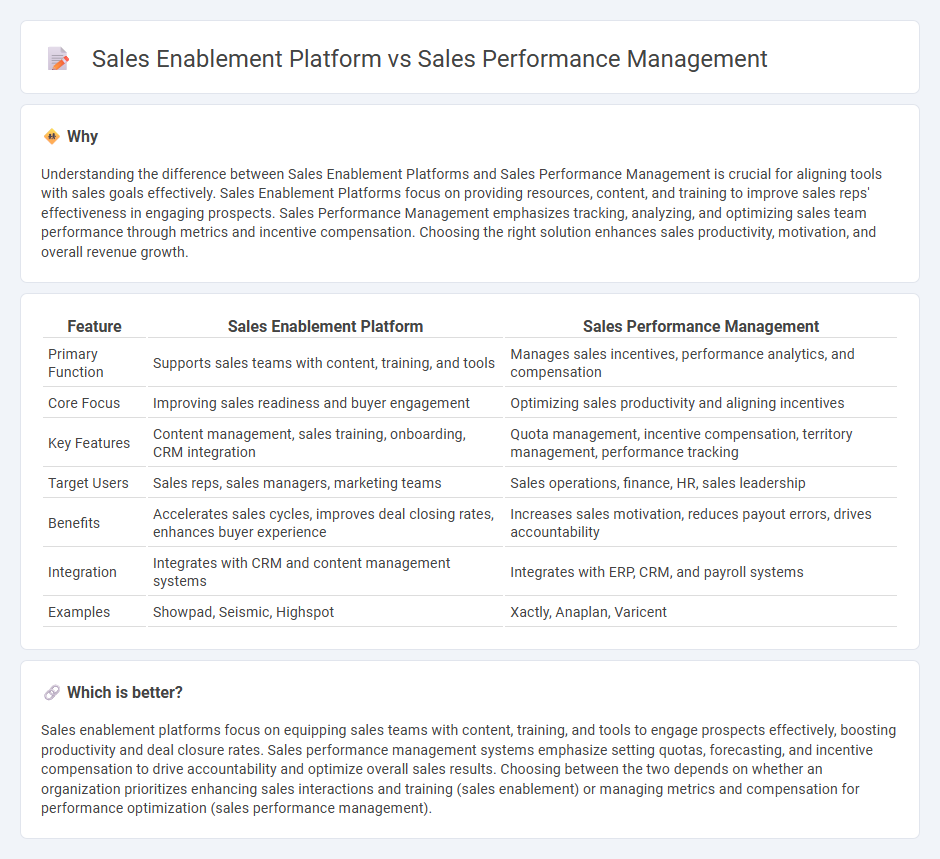
Sales enablement platforms streamline the distribution of training, content, and tools to improve sales team efficiency, while Sales Performance Management focuses on tracking, analyzing, and optimizing individual and team sales outcomes through metrics and incentives. Both solutions aim to boost revenue growth but address distinct aspects of the sales process, with enablement emphasizing skill enhancement and performance management targeting goal achievement. Explore how integrating these systems can maximize your sales force effectiveness.
Why it is important
Understanding the difference between Sales Enablement Platforms and Sales Performance Management is crucial for aligning tools with sales goals effectively. Sales Enablement Platforms focus on providing resources, content, and training to improve sales reps' effectiveness in engaging prospects. Sales Performance Management emphasizes tracking, analyzing, and optimizing sales team performance through metrics and incentive compensation. Choosing the right solution enhances sales productivity, motivation, and overall revenue growth.
Comparison Table
| Feature | Sales Enablement Platform | Sales Performance Management |
|---|---|---|
| Primary Function | Supports sales teams with content, training, and tools | Manages sales incentives, performance analytics, and compensation |
| Core Focus | Improving sales readiness and buyer engagement | Optimizing sales productivity and aligning incentives |
| Key Features | Content management, sales training, onboarding, CRM integration | Quota management, incentive compensation, territory management, performance tracking |
| Target Users | Sales reps, sales managers, marketing teams | Sales operations, finance, HR, sales leadership |
| Benefits | Accelerates sales cycles, improves deal closing rates, enhances buyer experience | Increases sales motivation, reduces payout errors, drives accountability |
| Integration | Integrates with CRM and content management systems | Integrates with ERP, CRM, and payroll systems |
| Examples | Showpad, Seismic, Highspot | Xactly, Anaplan, Varicent |
Which is better?
Sales enablement platforms focus on equipping sales teams with content, training, and tools to engage prospects effectively, boosting productivity and deal closure rates. Sales performance management systems emphasize setting quotas, forecasting, and incentive compensation to drive accountability and optimize overall sales results. Choosing between the two depends on whether an organization prioritizes enhancing sales interactions and training (sales enablement) or managing metrics and compensation for performance optimization (sales performance management).
Connection
Sales enablement platforms provide tools and content that empower sales teams to engage customers effectively, while Sales Performance Management (SPM) tracks and analyzes sales activities to optimize productivity and results. Integrating these systems ensures alignment between sales content delivery and performance metrics, driving higher revenue growth and improved sales effectiveness. Data from SPM informs enablement strategies by identifying skill gaps and coaching opportunities, creating a continuous cycle of sales improvement.
Key Terms
Sales Performance Management:
Sales Performance Management (SPM) focuses on driving sales effectiveness through performance analytics, incentive compensation, quota setting, and territory management, ensuring sales teams meet organizational goals efficiently. Unlike Sales Enablement platforms that center on content delivery and training, SPM provides data-driven insights and automation to optimize sales processes and motivate reps. Explore the advantages of Sales Performance Management to enhance your sales strategy and maximize revenue outcomes.
Quota Attainment
Sales Performance Management (SPM) platforms concentrate on forecasting, tracking, and optimizing quota attainment by providing detailed analytics and compensation management tools. Sales enablement platforms primarily focus on equipping sales teams with content, training, and engagement tools that indirectly support quota achievement by enhancing skills and customer interactions. Explore more to understand how each solution uniquely drives sales success and quota attainment.
Incentive Compensation
Sales Performance Management (SPM) centers on optimizing incentive compensation to drive sales force motivation through structured reward systems and performance analytics. Sales enablement platforms support sales teams by providing tools, content, and training to enhance selling capabilities but do not primarily manage compensation strategies. Discover how integrating both can maximize sales outcomes and motivate your team effectively.
Source and External Links
What is Sales Performance Management (SPM)? - Xactly - Sales Performance Management (SPM) is a system of structured processes to align incentive programs with company goals, improve sales planning, tracking, compensation, process automation, territory and quota management to drive predictable revenue growth through visibility and accountability.
What Is Sales Performance Management? Examples and Tips - Salesforce - SPM helps sales organizations track, manage, and improve sales team performance through sales planning, territory alignment, compensation/incentives, and quota management with data-driven strategies and motivational programs.
What Is Sales Performance Management? Benefits, How-tos, & Tips - Oracle - Sales Performance Management is the process of forecasting, planning, monitoring, and rewarding sales activities using digital tools and machine learning to align sales strategy with individual goals and increase revenue.
 dowidth.com
dowidth.com